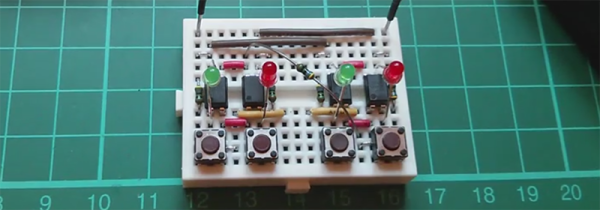You’ve seen CMOS logic, you’ve seen diode-resistor logic, you’ve seen logic based on relays, and some of you who can actually read have heard about rod logic. [Julian] has just invented optoisolator logic. He has proposed two reasons why this hasn’t been done before: either [Julian] is exceedingly clever, or optoisolator logic is a very stupid idea. It might just be the former.
Inside each optoisolator is a LED and a phototransistor. There’s no electrical connection between the two devices, which is exactly what you need in something that’s called an isolator. [Julian] was playing around with some optoisolators one day to create a weird push-pull circuit; the emitter of one phototransistor was connected to the collector of another. Tying the other ends of the phototransistor to +5V and Gnd meant he could switch between VCC and VDD, with every other part of the circuit isolated. This idea whirled around his mind for a few months until he got the idea of connecting even more LEDs to the inputs of the optoisolators. He could then connect the inputs of the isolators to +5V and Gnd because of the voltage drop of four LEDs.
A few more wheels turned in [Julian]’s head, and he decided to connect a switch between the two optoisolators. Connecting the ‘input’ of the circuit to ground made the LED connected to +5V light up. Connecting the input of the circuit to +5 made the LED connected to ground light up. And deeper down the rabbit hole goes [Julian].
With a few more buttons and LEDs, [Julian] created something that is either an AND, NAND, OR NOR, depending on your point of view. He already has an inverter and a few dozen more optoisolators coming from China.
It is theoretically possible to build something that could be called a computer with this, but that would do the unique properties of this circuit a disservice. In addition to a basic “1” and “0” logic state, these gates can also be configured for a tri-state input and output. This is huge; there are only two universal gates when you’re only dealing with 1s and 0s. There are about 20 universal logic gates if you can deal with a two.
It’s not a ternary computer yet (although we have seen those), but it is very cool and most probably not stupid.
Video below.











